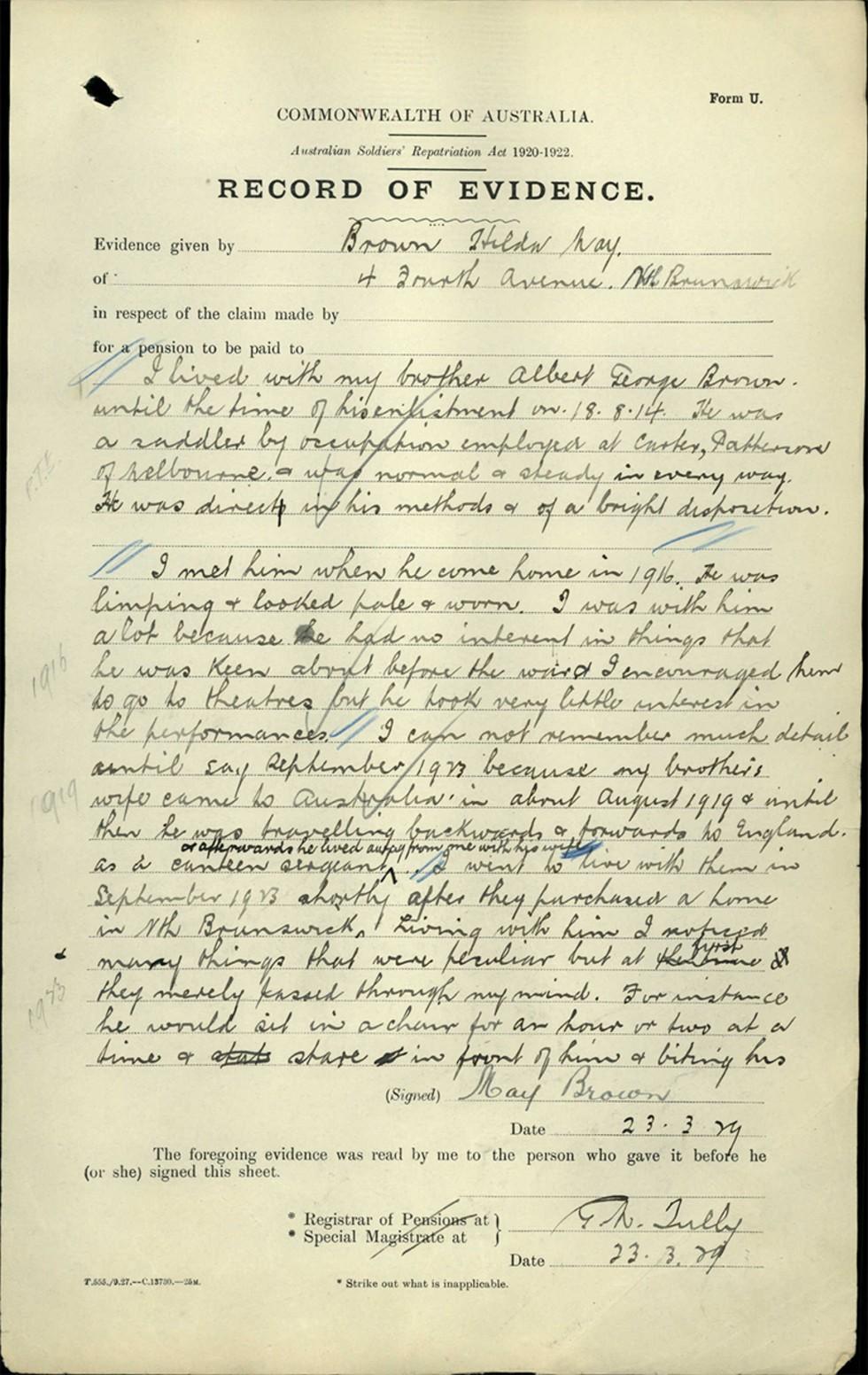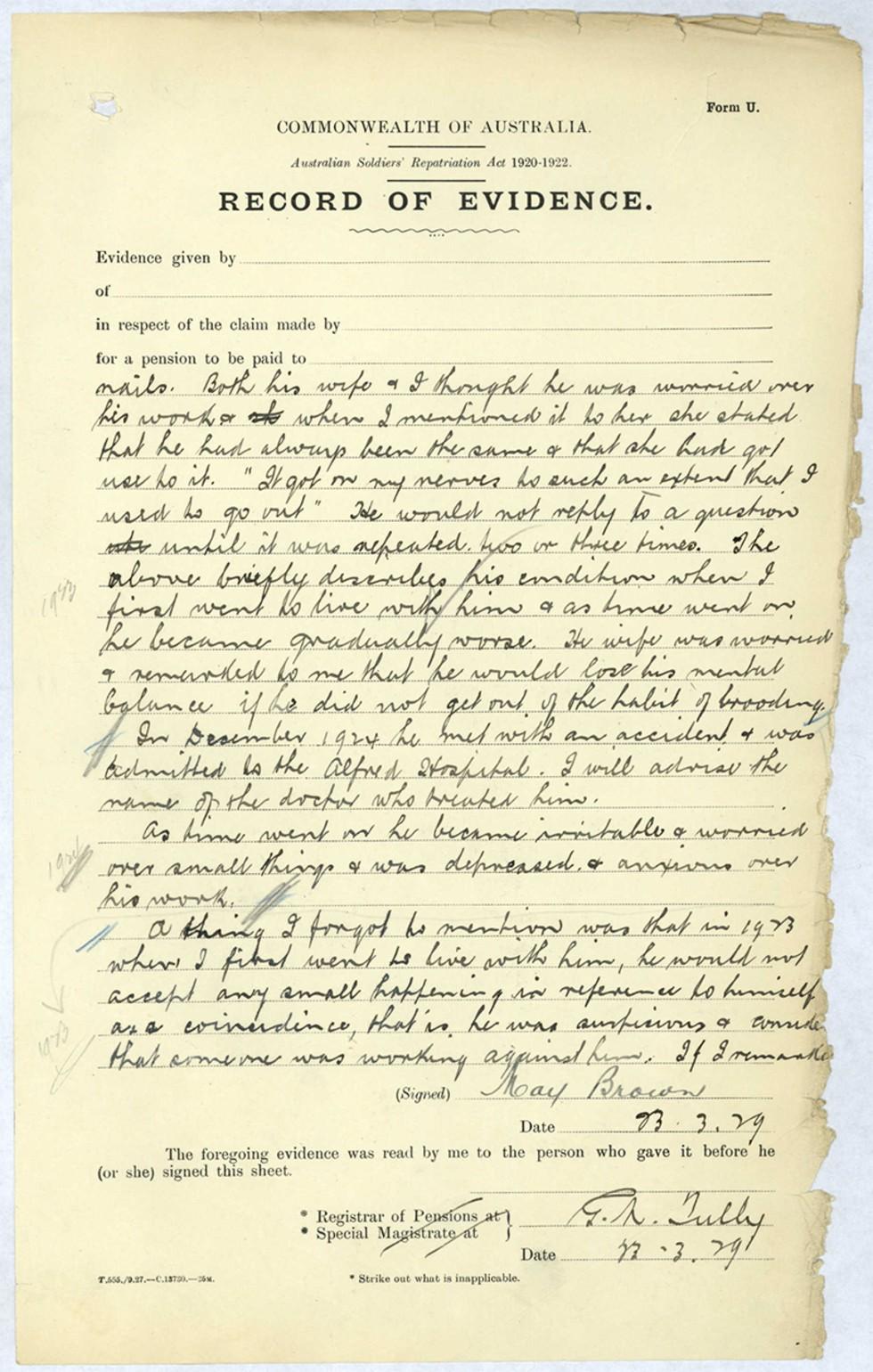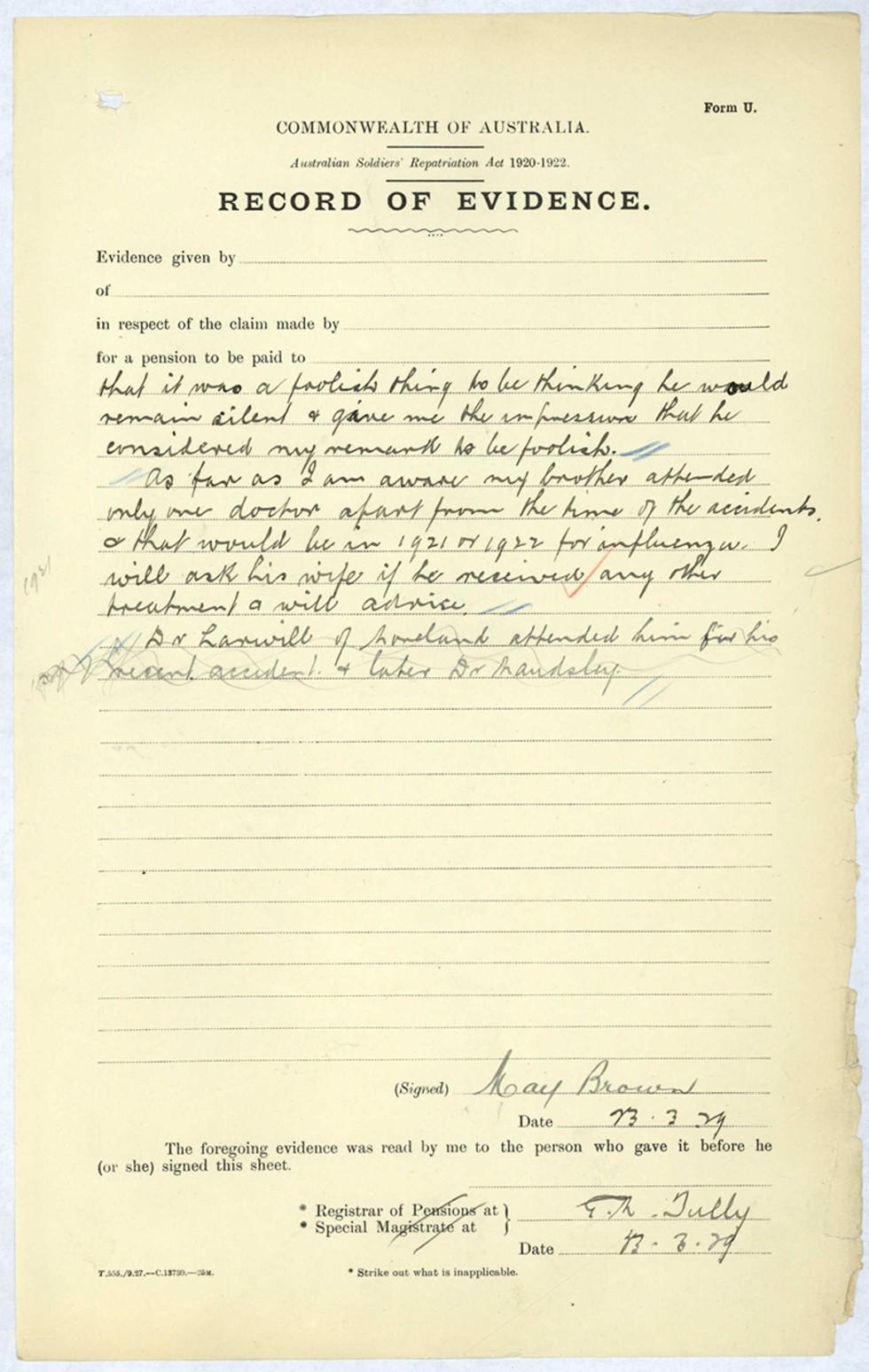


Aboriginal and Torres Strait Islander people should be aware that the National Archives' website and collection contain the names, images and voices of people who have died.
Some records include terms and views that are not appropriate today. They reflect the period in which they were created and are not the views of the National Archives.




[Page 1]
Form U
COMMONWEALTH OF AUSTRALIA
Australian Soldier’s Repatriation Act, 1920 – 1922
RECORD OF EVIDENCE.
Evidence given by [Handwritten] Brown Hilda May [end handwritten]
of [Handwritten] 4 South avenue. Nth [North] Brunswick [end handwritten]
in respect of the claim made by [blank space for response]
for a pension to be paid to [blank space for response]
[The following is handwritten in black ink. In the left margin, it has been annotated 'P.T.E.' (prior to enlistment), '1916', '1919', '1923', with blue dividing lines added to the text to separate each period described.]
I lived with my brother Albert George Brown until the time of his enlistment on 18.8.14. he was a saddler by occupation employed at Carter, Pattemore of Melbourne & was normal & steady in every way. He was direct in his methods & of a bright disposition.
I met him when he came home in 1916. He was limping and looked pale & worn. I was with him a lot because he had no interest in things that was keen about before the war & I encouraged him to go to the theatres but he took very little interest in the performances. I can not remember much detail until say September 1923 because my brother’s wife came to Australia in about August 1919 & until then he was travelling backwards & forwards to England as a canteen sergeant [note inserted here by author ‘& afterwards he lived away from me with his wife’]. I went to live with them in September 1923 shortly after they purchased a home in Nth [North] Brunswick. Living with him I noticed many things that were peculiar but at first [word crossed out] they merely passed through my mind. For instance, he would sit in a chair for an hour or two at a time & [word crossed out] stare in front of him & biting his
[End handwritten text]
Signed [Handwritten signature] May Brown
Date [Handwritten] 23.3.29
The foregoing evidence was read by me to the person who gave it before he (or she) signed this sheet.
[Crossed out] *Registrar of Pensions at
[Crossed out] *Special Magistrate at
*Strike out what is inapplicable
[Handwritten signature] G.M. Tully
Date [Handwritten] 22.3.29
[Page 2]
Form U
COMMONWEALTH OF AUSTRALIA
Australian Soldier’s Repatriation Act, 1920 – 1922
RECORD OF EVIDENCE.
Evidence given by [blank space]
of [blank space]
in respect of the claim made by [blank space]
for a pension to be paid to [blank space]
[The following is handwritten, continued from page 1. It is annotated in the margins '1923', '1924', '1923', with dividing lines added to the text to separate these periods.]
nails. Both his wife & I thought he was worried over his work & [word crossed out] when I mentioned it to her she stated that he had always been the same & that she had got used to it. "It got on my nerves to such an extent that I used to go out." He would not reply to a question [word crossed out] until it was repeated two or three times. The above briefly describes his condition when I first when to live with him & as time went on he became gradually worse. His wife was worried & remarked to me that he would lose his mental balance if he did not get out of the habit of brooding. In December 1924 he met with an accident & was admitted to the Alfred Hospital. I will advise the name of the doctor who treated him.
As time went on he became irritable & worried over small things & was depressed & anxious over his work.
A think I forgot to mention was that in 1923 when I first went to live with him, he would not accept any small happening in reference to himself as a coincidence, that is, he was suspicious & [illegible] that someone was working against him. If I remarked
[End handwritten text]
Signed [Handwritten signature] May Brown
Date [Handwritten] 23.3.29
The foregoing evidence was read by me to the person who gave it before he (or she) signed this sheet.
[Crossed out] *Registrar of Pensions at
[Crossed out] *Special Magistrate at
*Strike out what is inapplicable
[Handwritten signature] G.M. Tully
Date [Handwritten] 22.3.29
[Page 3]
Form U
COMMONWEALTH OF AUSTRALIA
Australian Soldier’s Repatriation Act, 1920 – 1922
RECORD OF EVIDENCE.
Evidence given by [blank space]
of [blank space]
in respect of the claim made by [blank space]
for a pension to be paid to [blank space]
[The following is handwritten, continued from page 2. The second paragraph is annotated '1921' in the margin.]
that it was a foolish think to be thinking he would remain silent & give me the impression that he considered my remark to be foolish.
As far as I am aware my brother attended only one doctor apart from the time of the accidents & that would be in 1921 or 1922 for influenza. I will ask his wife if he received any other treatment & will advise.
[Crossed out] Dr Larwill of [illegible] attended him for his recent accident & later Dr Mandeley.
Signed [Handwritten signature] May Brown
Date [Handwritten] 23.3.29
The foregoing evidence was read by me to the person who gave it before he (or she) signed this sheet.
[Crossed out] *Registrar of Pensions at
[Crossed out] *Special Magistrate at
*Strike out what is inapplicable
[Handwritten signature] G.M. Tully
Date [Handwritten] 22.3.29
This document is a ‘record of evidence’ completed by May Brown in 1929, which describes the mental state of her brother, First World War veteran Albert George Brown. This record is found within Albert’s First World War repatriation file. May included evidence from others, statement, along with additional evidence from others, including medical examiners and employers. This led the Repatriation Department to accept that Albert’s nervous condition was due to his war service.
Learn how to interpret primary sources, use our collection and more.
